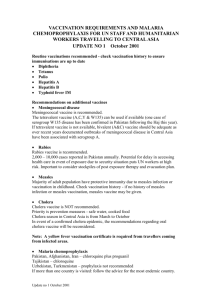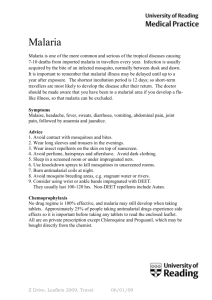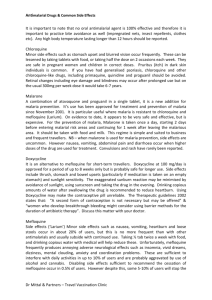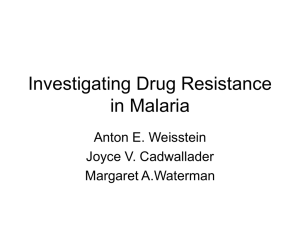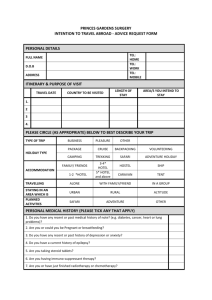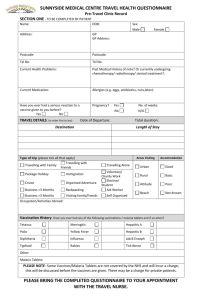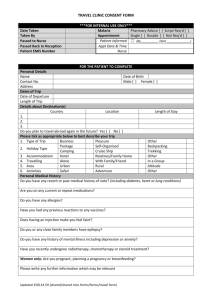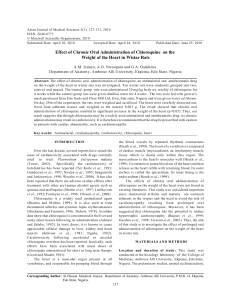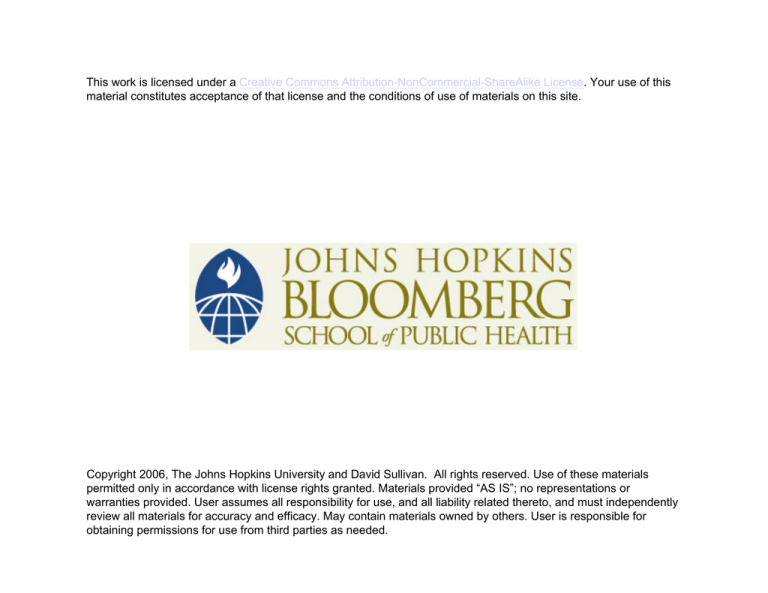
This work is licensed under a Creative Commons Attribution-NonCommercial-ShareAlike License. Your use of this
material constitutes acceptance of that license and the conditions of use of materials on this site.
Copyright 2006, The Johns Hopkins University and David Sullivan. All rights reserved. Use of these materials
permitted only in accordance with license rights granted. Materials provided “AS IS”; no representations or
warranties provided. User assumes all responsibility for use, and all liability related thereto, and must independently
review all materials for accuracy and efficacy. May contain materials owned by others. User is responsible for
obtaining permissions for use from third parties as needed.
Malaria Chemotherapy
and Drug Resistance
David Sullivan, MD
Eradication Attempts
•
•
•
•
•
•
•
Hookworm 1909-1924: Sanitation and drug treatment; no
reduction in 15 yrs.
Yellow Fever 1915-1930s: Mosquito control; discovery of natural
reservoir in jungle animals ceased efforts.
Yaws 1940-1960: Mass screening and penicillin; continued
spread after best efforts.
Malaria 1955-1975: DDT & chloroquine; $2 billion spent;
insecticide resistance & African failure of DDT ceased efforts.
Smallpox 1967-1977: Successful vaccine heat stable and 99%
effective as single dose; no hidden carriers.
Dracunculiasis 1986-?: 3.5 million to 100,000; Sudan - 605 of
current cases; Nigeria increase; surveillance and water control
Polio 1985-?: Gone from western hemisphere; problematic in
Congo, Sudan, and Afghanistan; vaccination- and surveillancebased control.
If Not Eradication, Then Control!
"At this time one must question the wisdom of even
contemplating another eradication effort until the two eradication
programs now in progress have been successfully concluded, until the
lessons from those programs have been digested and until the savings
from polio eradication have begun to be realized.
Furthermore, there is at this time no candidate disease for
which there is a sound scientific basis for eradication, for which the
epidemiologic feasibility of doing so is clear and for which there is a
reasonable expectation of political commitment by both afflicted
countries and those expected to provide the added resources."
DA Henderson
Malaria Control
Vaccines
"Stimulate the Phagocytes. Drugs are a Delusion " GB
Shaw, The Doctor's Dilemma 1906
Bednets
"I myself have been infected with malaria only
once in spite of nineteen years' of service in India and
thirteen subsequent 'malaria expeditions' to warm
climates; and I attribute this to my scrupulous use of the
bed net." Ronald Ross Studies on Malaria 1928.
Chemotherapy
"We must learn to shoot microbes with magic
bullets." Paul Ehrlich in Microbe Hunters Paul de Kruif
1926
oocysts
Sporozoites
Antifolates-proguanil,
pyrimethamine
Gametocytes
Primaquine
(hypnozoites of
P.vivax&ovale)
trophozoite
Artemisinin
Quinolines- chloroquine,
mefloquine, quinine
Antibacterials-tetracycline,clindamycin,
fluoroquinolone(Cipro)
}
Sporozoites
merozoites
schizont
48-72 hrs
ring
Atovoquone
Classification of Antimalarial Agents
1. Tissue Schizontocidal Drugs
a. Causal Drugs: Eliminate liver stage from initiating erythrocytic stage
b. Hypnozoitocidal: Radical cure of exo-erythrocytic hypnozoites of P.
vivax and P. ovale after treatment of acute erythrocytic phase
2. Blood Schizontocidal Drugs
3. Clinical Cure: Fast action on erythrocytic stages- artemisinin and
quinolines
4. Suppresive Therapy: Slower suppressive action on erythrocytic stages
5. Gametocytocidal Drugs: Destroy sexual erythrocytes preventing
transmission to mosquito
6. Sporontocidal Drugs: Prevent formation in mosquito of oocyst and
sporozoites
7. Chemoprophylaxis
a. Causal: Eliminate liver stage from initiating erythrocytic stage
b. Clinical or Also Suppressive: Eliminates development of
merozoites in erythrocytes.
Five Broad Groups Based on Mechanism
of Action
1. Quinoline: Inhibits heme crystallization
2. Artemisinin: 1. Binds heme iron and or iron and generates
oxygen radicals. 2. Damages SERCA Ca++ P-ATPase
3. Antifolate: Inhibit DNA synthesis
4. Atovaquone: Collapses mitochondrial membrane potential
5. Antibacterial: ribosome inhibition-tetracycline, clindamycin and
erythromycin, DNA gyrase inhibition-fluoroquinolones
Plasmodium Specialized Organelles
•
Digestive vacuole physiology or the Plasmodium iron problem
•
Specialized lysosome for degrading hemoglobin and making
malarial pigment
•
Mitochondria-lack of active TCA cycle with 99% energy from
glycolysis
•
Apicoplast-chloroplast origin, makes heme and fatty acids and
has prokaryote ribosomes
Ehrlich: specific receptors in the parasite with higher avidity for
drug than those present in host or ideally lacking in host. He
developed arsenicals and methylene blue for the treatment of
sleeping sickness and syphilis.
Perkins: In 1826. while trying to make quinine from coal tar, made
aniline dye-mauve, which spawned dye industry and later stains
for bacteria. Prontosil was made for its color fastness.
Plasmodium Hemoglobin Degradation
Hemoglobin
Plasmepsins I & II
Heme Release
Large Fragments
Polymerization
Hemozoin
Falcipain
Small Peptides
TXPORT
Amino Acids
(Cytoplasm)
The Matter With Iron
and Heme Metabolism
P. falciparum invades a host cell with 20 mM heme iron that can
make O2 radicals in an acidic vacuole.
P. falciparum lacks heme oxygenase and
has to synthesize its own heme.
Iron chelators kill the parasite.
Head to tail dimer
of adjacent
hemozoin
hemes
Ring
Troph-Schizont
Formation of Hemozoin Detoxifies
Reactive Heme By Coordinate
Iron-Oxygen Bond.
Quinoline Inhibition of Heme Crystallization
1.
Stage specificity for killing of parasites actively degrading hemoglobin
2.
Hyper- concentration to millimolar levels in the digestive vaculoe from
nanomolar levels in plasma
3.
Digestive vacuolar swelling as early morphologic effects of quinoline
treatment
Previous theories postulated that the chloroquine-induced disruption of heme
crystallization results either from binding of drug to heme with sequestration of
monomeric substrate or from direct interaction of chloroquine with a
crystallization protein.
The molecular mechanism of action of quinoline inhibition of heme
crystallization was unanswered.
Quinoline mechanism of action: still not fully
resolved
Quinolines copurify with heme crystals in subcellular
fractionations
Quinolines reversibly inhibit heme crystallization in
time, temperature dependent and pH dependent
fashion.
The membrane Pfchloroquine resistant transporter is
on digestive vacuole membrane.
Debate still ongoing if quinoline acts in digestive
vacuole or cytosol? How much heme is uncoupled
from crystallization? Is a single head to tail heme
dimer toxic like monomeric heme?
Drug Targets
4-Aminoquinolines - Chloroquine
1.
2.
Chloroquine
a. More rapidly acting than quinine and much less toxic.
b. Has a much longer half-life than quinine
c. Used for amebic hepatitis and rheumatologic disorders.
d. Principal metabolite desethylchloroquine has approximately equal
antimalarial activity.
e. Antipyretic effect as well as an antimalarial.
f. Side Effects: Cinchonism; pruritus in dark-skinned people can be dose
limiting; very rare acute neuropsychiatric syndrome; residents on long
term prophylaxis should have vision checked after 5 years on drug;
diazepam is antidote for poisoning.
Amodiaquine
a. More active against chloroquine resistant isolates but more toxic
b. Side effects: 1 in 2000 develop agranulocytosis (no white blood cells);
serious hepatotoxicity can occur; cinchonism and pruritus also.
Quinine & Quinidine
1. Quinine
a. General protoplasmic poison
b. Bitter powder from bark of cinchona tree used as flavoring and treatment
of night cramps as well as an antimalarial
c. Not a potent antipyretic but has this effect
d. Very complex to synthesize and still obtained from natural sources
e. Secondary alcohol group essential for function
f. Side effects: Cinchonism symptom complex of tinnitus (ringing in the
ears); high tone hearing impairment; nausea, dysphoria, and vomiting; can
affect cardiac electrical rhythm by prolonging repolarization; blindness and
deafness are common following self-poisoning (8 g orally is fatal), but are
rare in malaria treatment; most important side effect is stimulation of
pancreatic beta cells to cause hyperinsulinemic hypoglycemia; does not
cause premature labor and actually lessens contractions in malarious
women that are treated; associated with blackwater fever but mechanism
is unclear and association is not absolute
2. Quinidine
a. dextrorotatory diastereoisomer of quinine. A more active antimalarial but
more cardiotoxic
b. Side effects: effect on heart, effect on pancreas, and deafness
Mefloquine and Halfantrine
•
Mefloquine
a. Used as a 50:50 racemic mixture of the erythroisomers.
b. Very insoluble in water
c. Side Effects: Most people vomit after first loading dose for treatment. As
chemoprophylactic, 1:15,000 incidence of acute and self-limiting
neuropsychiatric reactions (nightmares, convulsions and psychosis). Ten
times incidence higher with treatment.
•
Halofantrine
a. More potent than quinine or mefloquine
b. Side Effects: well-tolerated, diarrhea at high doses. Sudden death from
cardiac causes potentiated with previous mefloquine treatment.
Acridine
Mepacrine: same side chain as chloroquine. More toxic but used in WWII
before chloroquine. Still used for giardiasis.
Side effects: people turn yellow and have skin eruptions and mental
disturbances
Benzonaphthyridines
Pyronaridine: Synthesized in China as reminiscent of Mepacrine and
Amodiaquine. Effective against multi-drug resistant plasmodium.
Side effects: headache, dizziness, gastrointestinal distress, and heart
abnormalities.
8-Aminoquinolines
1. Primaquine
a. Only drug class that kills hypnozoites of P. vivax and P. ovale.
b. Intermediate resistance of P. vivax to primaquine is appearing.
c. Ineffective against asexual blood forms of P. falciparum.
d. Kills gametocytes of all species of malaria including P. falciparum.
e. Mechanism of action: Possible metabolite interferes with
mitochondrial function.
f. Side effects: Hemolysis in persons with G6PD deficiency (an
antioxidant enzyme). Nausea, vomiting, and GI upset are
common, especially if more than 30 mg is taken
2. Tafenoquine (WR 238,605)
1. more than 10 times more active as hypnozoitocidal drug and has
blood schizontocidal activity and gametocidal activity.
2. Early report in Australian military that it causes a keratitis.
3. Drug studies still ongoing.
Artemisinin
1. Sesquiterpine lactone extracted from herb called sweet wormwood
(Artemesia annua).
2. Rapidly effective against malaria parasites including multiresistant
strains.
3. 4 log drop in parasite counts.
4. May become most important treatment for drug-resistant malaria.
5. No reported resistance.
6. Artemisisin suppositories
7. Artemether dissolved in peanut oil and given as intramuscular injection.
8. Artesunate: tablets or IV formulation
9. Pharmokinetics: t 1/2 of 1-3 hrs
10. Side effects: No clinical toxicity seen in thousands of people. Can have
neurotoxicity in animals. Anecdotal reports of embryo toxicity in rats
and mice and should be used with caution during pregnancy.
The Numbers
70 kg person X @70 mL/kg = 4.9 L of blood @ 5 L = 5X103 ml = 5X106 µL
5X106 RBCs per µL of blood
2.5 X 1013 RBCs
1% parasitemia = 1 in 100 iRBCs = 2.5 X 1011 parasites
Artemisinin reduces by 4 logs parasite biomass with each asexual cycle.
This is the most rapidly acting antimalarial.
Endoperoxide bridge
generates single
oxygen radical
Old “where the money is” theory: artemisinin makes
oxygen radicals in digestive vacuole where lots of oxygen
and heme coexist.
Target proteins
1.
2.
3.
4.
5.
Artemisinin increases lipid damage (Berman Adams 1997)
Histidine-rich protein or translationally controlled tumor protein TCTP covalent hemeart-protein adducts
Does not prevent heme crystallization even though binds heme
inhibits hemoglobin proteases in presence of heme
Binds and inhibits calcium transporter PfATPase6
New fact-artemisinin
inhibits calcium ATPase
pumpPfATP6 in parasite.
Iron chelator decreases
effect.
Nature 424:957-612003
Eckstein-Ludwig & Krishna
Dihyrofolate Reductase Inhibitors
Diaminopyrimidines
1. Pyrimethamine
a. Used in combination with long-acting sulfonamides.
b. Inhibits all stages except for late-stage gametocytes and
hypnozoites.
c. More potent than chloroguanide and has longer half life.
d. Side effects: Generally safe and well-tolerated with mild bone
marrow depression in persons with folate deficiency. Toxicity of
combination with sulfonamides due to sulfonamides.
2. Trimethoprim
a. (Bactrim) in combination with sulfamethoxazole.
b. Effective treatment for uncomplicated malaria.
Inhibition of Dihydrofolate Reductases by
Pyrimethamine and Trimethoprim
Concentration (nM) for 50% inhibition of DHFR
Inhibitor
Mammalian
Rat liver
Bacterial
E. coli
Protozoal
P. berghei
Pyrimethamine
700
2500
0.5
Trimethoprim
260,000
5
70
Adapted from Ferone,Burchall & Hitchings, 1969
Dihyrofolate Reductase Inhibitors
Diaminopyrimidines (cont.)
3.
Sulfadoxine
a. Long half-life up to 120-200 hours
b. Combination with pyrimethamine 20:1 known as Fansidar valuable in
curative treatment of resistant strains as well as prophylactic.
c. Clears as rapidly as chloroquine, but no antipyretic effect.
d. Side effects: Stevens-Johnson syndrome. Fatal reactions as high as
1:18,000-26,000 for chemoprophylaxis. Aplastic anemia and
agranulocytosis can occur.
Naphthoquinolines
1.
Atovaquone:
a. First used in the 1940's but rapid resistance when used alone.
b. Combination with tetracycline or proguanil will circumvent this.
c. In combination with dapsone, it is a very promising casual prophylactic.
d. Currently in combination with proguanil as Malarone.
Antibacterials
1.
Tetracycline
1. Blocks 30s ribosome in bacteria.
2. Useful in combination therapy with quinine for multiple-resistant
organisms.
3. Slow action.
4. Useful chemoprophylaxis in areas with multiresistant Plasmodium.
5. Side effects: Sun sensitivity; damages bones and teeth in fetus and
young children.
2.
Clindamycin
1. Blocks 50s ribosomes.
2. Treats mild malaria and can work against quinoline-resistant strains.
3. Azithromycin and erythromycin are similar and inhibit 50s ribosomes by
a slightly different mechanism.
3.
Fluoroquinolones
1. Inhibit DNA gyrases
2. Slight antimalarial activity.
Multiple-Drug Therapy: A forgotten lesson
Artemisinin/quinolines
Atovoquone/proguanil or dapsone
Quinolines/tetracycline
Adjunctive Therapy
Steroids: Worsened outcome in large study of cerebral
malaria patients.
Iron Chelation: Can only be given as continuous infusion
but hastens recovery in cerebral malaria patients and
does hasten clearance of parasitemia. Iron chelation is
bacteriostatic and inhibits growth but does not kill
mammalian cells. In culture. iron chelation kills
Plasmodium.
COARTEM
UNIQUE TARGETS FOR ANTIPLASMODIAL DRUGS
1)Unique essential metabolic pathway
Web page for Plasmodium metabolic pathways.
http://sites.huji.ac.il/malaria/
2)Inhibitor with differential activity- parasite vs. host
3)Cure disease
Rational drug development is identifying unique
targets present in Plasmodium but not host cells and are
essential for maturation.
1)Proteases involved in hemoglobin degradation
2)Orotic acid dehydrogenase activity in mitochondria
3)Phospholipid biosynthesis inhibitors
4)Every newly discovered unique Plasmodium
enzyme
Gametocytidal Activity
1.
Gametes degrade hemoglobin for 48 hrs before becoming relatively
metabolically inactive for the rest of 28-day life.
2.
Chloroquine and pyrimethamine/sulfadoxine both clear gametocytes within
28 days. Chloroquine enhances infectivity before clearance while Pyr/sulfa
decreases infectivity. Chloroquine-treated uninfected nonimmune serum
enhanced infectivity of gametocytes, while Pyr/sulfa decreased infectivity.
Hogh,B et al Am J Trop Med Hyg 58:176-182 1998.
3.
Mature gametocytes are metabolically resting and the quinolines and anti
folates do not effect them.
4.
Primaquin, tafenoquine and artemesinin are most effective at killing
mature gametocytes.
Sporontocidal Activity
•
Proguanil and pyrimethamine clearly are.
•
The sulfa drugs have varied effects.
•
Primaquine given in filter feeds does not work, but it is
effective when given to host (need metabolite).
Drug Regimens
1. Chemoprophylaxis
2. Curative
3. Intermittent presumptive therapy (pregnancy, disease prevention in
children)
4. Population treatments
Chemoprophylaxis Principles
1.
Avoid infection.
2.
No drug is perfectly effective; all have risks. 20% of all people taking
chemoprophylaxis report some effect.
3.
Prophylactic drugs like chloroquine, mefloquine, and tetracycline are not
designed to eliminate hypnozoites of P. vivax or P. ovale. Primaquine can
be given for radical cure if exposure is substantial (>6 months).
4.
Start chloroquine one week early to build up therapeutic doses. In
emergency travel, may take chloroquine on two consecutive days.
Chemoprophylaxis Principles (cont.)
5.
Continue drugs for 4 weeks (mefloquine 2 weeks) after leaving malarious
area so that schizontocidal concentrations are present when merozoites
emerge from liver. Mefloquine and Maloprim are started early to watch for
side effects. Alternative is to brings drugs along for standby treatment of
fevers for individuals who are pregnant, young children or people with
allergies.
6.
Chloroquine, quinine, pyrimethamine. and proguanil are safe during
pregnancy. Sulfonamides are safe at term. Mefloquine is still under
evaluation, but probably safe. Malorone is category C, probably safe but
some minimal animal toxicity with atovoquone.
7.
Chemoprophylaxis of children in endemic area has been shown to reduce
mortality (25%) but is not widely done.
P. falciparum
Is a
Medical
emergency
Initial Management Decisions
•
•
•
•
•
•
Oral vs. Intravenous chemotherapy
– Severity of disease
Correct Drug
– Resistance ?
Correct dose
– mg/kg of salt or base
Response to therapy
– Parasite clearance time
– Fever clearance time
Check the glucose
Hypoglycemia from parasite or drugs
Oral vs. Intravenous Chemotherapy
•
•
•
Signs of End Organ Involvement
– Pulmonary edema
– Renal failure
– Coma
– Severe anemia-transfusion lifesaving
Unable to Tolerate Oral Medications
Parasitemia over 5%
If yes to any of the above, then IV chemotherapy.
Delay Equals Bad Outcome
Delay from onset of symptoms to medical presentation
Delay from presentation until consideration of malaria
Delay from consideration to microscope diagnosis
Delay from diagnosis until start of therapy.
Delay of reassessment (ICU care;hypoglycemia; staff not as
familiar with IV Quinidine.
Pregnancy and Drugs
Chemoprophylaxis
• continuous provision of antenatal chemotherapy to prevent parasitemia.
Chemoprophylaxis during first pregnancy does not reduce immunity in
subsequent pregnancies.
• Chloroquine,amodiaquine, proguanil, mefloquine
Intermittent presumptive treatment (IPT)
• Full treatment doses at intervals to reduce disease.
• 2-3 intervals at scheduled visits.
• sulfadoxine-pyrimethamine
Treatment During Pregnancy
1.
2.
3.
4.
5.
6.
IV quinine
Chloroquine
SP
Artesunate combinations
Quinine and clindamycin
Amodiaquine
What Is Drug Resistance?
The ability of a parasite strain to survive and/or multiply despite
administration & absorption of a drug given in doses equal to or
higher than those usually recommended but within the limit of
tolerance of the subject. (World Health Organization, 1986)
Why Don’t Antimalarial Drug
Treatments Always Work?
•
•
•
•
•
•
•
•
Wrong Diagnosis
Incorrect choice of drugs
Sub-optimal regimen (dose, schedule, duration)
Non-compliance
Sub-optimal absorption (nausea, diarrhea, vomiting, malabsorption)
Idiosyncratic pharmacokinetics
Poor quality drugs
Resistance of the pathogen to the drug
Antimalarial Drug Resistance: Social,
Economic, Host, and Parasite
Sensitive vs. resistant
parasites; Biomass;
Multiplication rate
Pharmacokinetics
Absorption; distribution; metabolism; elimination;
penetration of RBC membrane
Parasite
Access to treatment;
political stability;
perception of illness
Host
Culture
Immune Responses
Nonspecific & specific;
genetics; age; pregnancy
Mechanisms of Resistance: Quinolines
•
Resistant parasites accumulate less drug. (period)
•
Strains can be sensitive to one quinoline (quinidine) and resistant to
another (chloroquine).
•
Theories propose drug increased efflux vs. decreased drug influx.
•
Pf Multi Drug Resistant (MDR) gene does not correlate with CQR, but
mostly with MFQR.
•
PfCRT-Positional cloned to chromosome 7. No homology to other
pumps.
•
Biochemical changes in parasite pH from 7.1 to 7.3 distinguishes
sensitive from resistant parasites, respectively. J Cell Biol 140:335-345
Antimalarial drug resistance mutations
Low- to intermediate-level resistance
High-level resistance
P. falciparum
Chloroquine CRT; 76
CRT; 76 and other mutations,
MDR;86, and other undefined gene products
Mefloquine, halofantrine, lumefantrine
MDR; amplification of wild-type allele
Pyrimethamine DHFR; 108 then 51 and 59
DHFR; 108 + 51 + 59 + 164
Cycloguanil, Chlorcycloguanil DHFR; 16 + 108
DHFR; 108 + 51 + 59 + 164
Atovaquone No low-level resistance documented Cytochrome
b; 133 ± 280
Sulfonamides and sulfones DHPS; 436, 437, 540, 581, 613A
Artemisinin and derivatives No resistance
P. vivax Pyrimethamine DHFR; 117 + 58 DHFR; 117 + 58 +
59 + 61 + 13
Atovoquone mutation on cyt B

